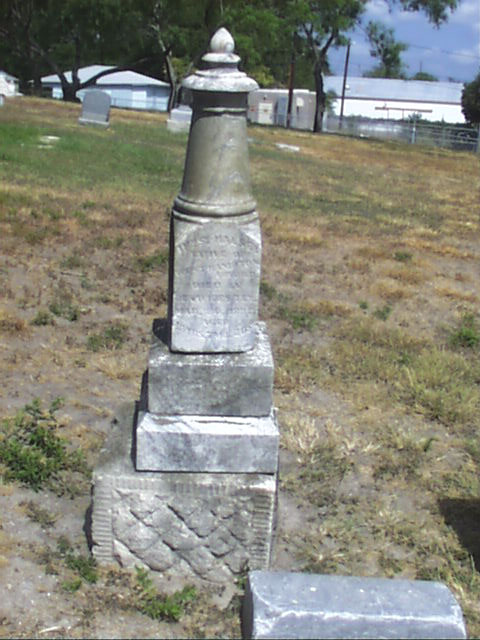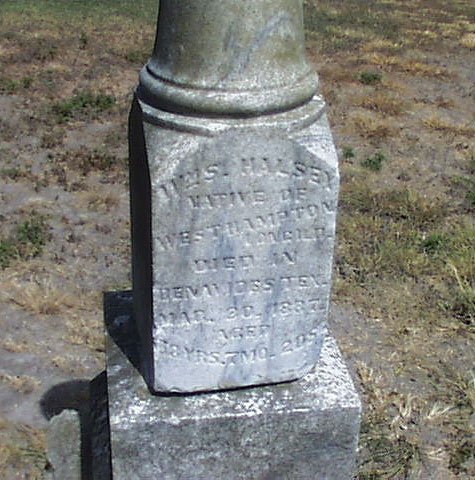William S. Halsey
Wm. S. Halsey
native of
Westhampton
Long Ild.
died in
Benavides, Tex
Mar. 31, 1887


Photo Credit: Rosa G. Gonzales
1. Photograph of William S. Halsey
Provenance: Melissa Chote Byrne
Submitted by: Geraldine McGloin, Nueces County Historical Commission
Photo from tintype
2. Obituary
DIED
HALSEY- At Benavides', Duval county at 3:50 p.m., Wednesday, March 30 1887, of paralysis, W. S. Halsey, aged about 58 years. The remains were brought to this city Thursday for burial, the funeral taking place at 10:30 a.m., yesterday from the residence of Mr. Ed. Beard. Mr. Halsey was born in Westhampton, Long Island, January 28, 1838; came to Nueces county in 1856 and was married to Miss Olivia P. Davis of this county January 22d, 1860. At one time he held the office of sheriff of Starr county. He was also inspector on the Rio Grande. For several years he resided in Corpus Christi, moving from this place to Benavides only a few months ago to engage in the mercantile business.
He was first stricken with paralysis in Sept. 1885, since which time he has been in poor health. Mrs. Halsey leaves a wife, five daughters and one son. The funeral was largely attended by citizens of Corpus Christi and Benavides'. The deceased leaves many friends who mourn his loss. The afflicted family have the sympathies of the entire community.
Source: Corpus Christi Caller-Times, p. 5, April 2, 1887
Research/transcription: Geraldine D. McGloin, Nueces County Historical Commission
3. News Item, 1885
Bitten by an Oyster
The curiosity of the season was exhibited at the Caller office last week by Mr. W. S. Halsey. It was a wild duck caught and killed by an oyster. It is the first time we have ever seen or heard of an oyster successfully bagging game, but the evidence of this incident was too strong to be doubted. The duck was a large and full grown one that had recently come from the north to enjoy our winter climate. It was of the diving species, which inhabit the bays till the spring, when they return north. The duck had evidently seen a large fat oyster enjoying a drink of fresh water in its freedom on the bottom of the bay. When the oyster feeds it opens its shell wide till the full oyster is plainly visible. A sight of such a morsel was too much for the duck. He made a headlong plunge, inserting his bill between the oyster's open shells. Like a flash and with the power of a vise the shells closed on the duck's beak. Then came the struggle for life. The oyster, which was quite a large one, was dragged from its bed with three smaller ones clinging to it-the cluster being heavy enough to keep the duck's head under water. It this way the duck drowned. Its buoyancy was sufficient to float with the oysters, and thus drifted near the dock where it was captured by Mr. Halsey. When taken out of the water the animal heat had not left the duck. The oyster still clung to the duck's beak and with such force as to mash and __________ it considerably. This species of duck is fond of oysters and muscles and no doubt many are thus caught and anchored to the bottom of the bay in their eagerness to capture fat oysters.
Source: Corpus Christi Caller, November 23, 1884, p. 5, col. 2
Research by: Msgr. Michael A. Howell
Transcription by: Geraldine D. McGloin, Nueces County Historical Commission